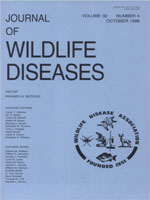Although antibodies to viruses in both the epizootic hemorrhagic disease virus (EHDV) and bluetongue virus (BTV) serogroups have been reported from white-tailed deer (Odocoileus virginianus) in Texas (USA), there are few reports of hemorrhagic disease (HD) in these populations. To understand the extent and diversity of exposure to the North American EHDV and BTV serotypes in these deer populations, we serologically tested 685 white-tailed deer collected from November 1991 through March 1992 throughout their range in Texas. Overall, 574 (84%) of deer had antibodies to EHDV or BTV Prevalence estimates varied according to ecological region, from 57% in the Gulf Prairies to 100% in the northwest Edwards Plateau. Based on serum neutralization tests, the deer had evidence of previous exposures to multiple EHDV and BTV serotypes, with evidence of exposure to two to five serotypes detected in each ecological region. The apparent lack of HD in relation to this high antibody prevalence cannot be explained, but may be related to enzootic stability in which a near perfect host-virus relationship exists.
How to translate text using browser tools
1 October 1996
Hemorrhagic Disease in White-tailed Deer in Texas: A Case for Enzootic Stability
David E. Stallknecht,
M. Page Luttrell,
Kirk E. Smith,
Victor F. Nettles

Journal of Wildlife Diseases
Vol. 32 • No. 4
October 1996
Vol. 32 • No. 4
October 1996
bluetongue virus
epizootic hemorrhagic disease virus
epizootiology
hemorrhagic disease
Odocoileus virginianus
white-tailed deer




